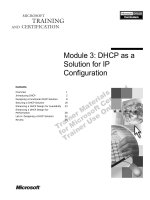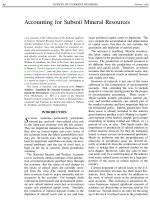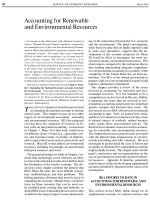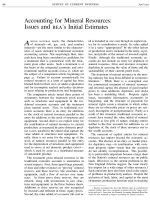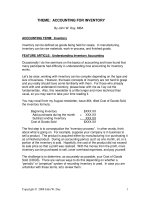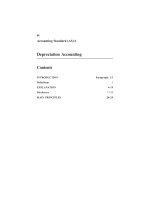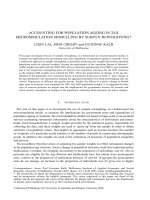Accounting Standard (AS) 12: Accounting for Government Grants pptx
Bạn đang xem bản rút gọn của tài liệu. Xem và tải ngay bản đầy đủ của tài liệu tại đây (186.29 KB, 9 trang )
124
Accounting Standard (AS) 12
Accounting for Government Grant
s
Contents
INTRODUCTION Para
g
raphs 1-3
Definitions 3
EXPLANATION 4-12
Accounting Treatment of Government Grants 5-11
Capital Approach versus Income Approach 5
Recognition of Government Grants 6
Non-monetary Government Grants 7
Presentation of Grants Related to Specific Fixed Assets 8
Presentation of Grants Related to Revenue 9
Presentation of Grants of the nature of Promoters’ contribution 10
Refund of Government Grants 11
Disclosure 12
MAIN PRINCIPLES 13-23
Disclosure 23
158 AS 12 (issued 1991)
Accounting Standard (AS) 12
Accounting for Government Grants
(Thi
s
A
ccountin
g
S
tanda
r
d include
s
p
aragraph
s
s
et in bold
i
t
alic type
and plain type, which have equal authority. Paragraphs in bold italic typ
e
indicate the main principles. This Accounting Standard should be read in
the context of the General Instructions contained in part A of the
A
nnexure to the Notification.)
Introduction
1. This Standard deals with accounting for government grants.
Government grants are sometimes called by other names such as subsidies,
cash incentives, duty drawbacks, etc.
2. This Standar
d
does not deal with:
(i) the special proble
m
s arising in accounting fo
r
government grants in
financial statements reflecting the effects of changing prices or i
n
supplementary information of a similar nature;
(ii) government assistance othe
r
than in the fo
r
m
of government grants;
(iii) government participation in the ownership of the enterprise.
Definitions
3. The following terms are used in this Standard with the meanings
s
peci
f
ied:
3.1 Governmen
t
re
f
ers to
g
overnment
,
g
overnment a
g
encies and
s
imilar bodies whether local, national or international.
3.2 Government
g
ran
t
s a
r
e assistance b
y
g
overnmen
t
i
ncasho
r
kin
d
to an enterprise for past or future compliance with certain conditions.
They exclude those forms of government assistance which cannot
reasonably have a value placed upon them and transactions with
g
overnment which cannot be distinguished from the normal tradin
g
transactions of the enterprise.
126 AS 1
2
Explanation
4. The receipt of government grants by an enterprise is significant for
preparation of the financial statements for two reasons. Firstly, if
a
government grant has been received, an appropriate method of accountin
g
therefor is necessary. Secondly, it is desirable to give an indication of th
e
extent to which the enterprise has benefited from such grant during th
e
reporting period. This facilitates comparison of an enterprise’s financia
l
statements with those of prior periods and with those of other enterprises.
Accountin
g
Treatment of Government Grants
5. Capita
l
A
pp
r
oach versu
s
Income
A
pp
r
oach
5.1 Two broad approaches may be followed for the accounting treatment
of government grants: the ‘capital approach’, under which a grant is treate
d
as part of shareholders’ funds, and the ‘income approach’, under which
a
g
rant is taken to income ove
r
one o
r
more periods.
5.2 Those in su
pp
o
r
t of the ‘ca
p
ital a
pp
roach’ a
r
g
ue as follows:
(i) Many government grants are in the nature of promoters’
contribution, i.e., they are given with reference to the tota
l
investment in an undertaking or by way of contribution toward
s
its total capital outlay and no repayment is ordinarily expected i
n
the case of such grants. These should, therefore, be credited directly
to shareholders’ funds.
(ii) It is inappropriate to recognise government grants in the profit
and loss statement, since they are not earned but represent an
incentive provide
d
b
y
g
overnment without relate
d
costs.
5.3 A
r
g
uments in su
pp
o
r
t of the ‘income a
pp
roach’ a
r
e as follows:
(i) Governme
n
t grants a
r
e rarely gratuitous. The enterprise earns the
m
through compliance with their conditions and meeting th
e
envisaged obligations. They should therefore be taken to incom
e
and matched with the associated costs which the grant is intende
d
to compensate.
(ii) As income tax and other taxes are charges against income, it i
s
logical to deal also with government grants, which are an extensio
n
of fiscal policies, in the profit and loss statement.
A
ccounting for Government Grants 127
(iii) In case grants a
r
e credite
d
to shareholders’ funds, no correlatio
n
is done between the accounting treatment of the grant and the
accounting treatment of the expenditure to which the grant relates.
5.4 It is generally considere
d
appropriate that accounting fo
r
government
grant should be based on the nature of the relevant grant. Grants which hav
e
the characteristics similar to those of promoters’ contribution should
be
treated as part of shareholders’ funds. Income approach may b
e
more appropriate in the case of other grants.
5.5 It is fundamental to the ‘income approach’ that government grants
b
e
recognised in the profit and loss statement on a systematic and rational
b
asi
s
over the periods necessary to match them with the related costs. Incom
e
recognition of government grants on a receipts basis is not in accordanc
e
with the accrual accounting assumption (see Accounting Standard (AS) 1
,
Disclosure of Accounting Policies).
5.6 In most cases, the periods ove
r
which an enterprise recognises the
costs or expenses related to a government grant are readily ascertainabl
e
and thus grants in recognition of specific expenses are taken to income i
n
the same period as the relevant expenses.
6
. Recognition o
f
Government Grants
6.1 Government grants available to the enterprise are considered for
inclusion in accounts:
(i) where there is reasonable assurance tha
t
the enterprise will comply
with the conditions attached to them; and
(ii) where such benefits have been earned by the enterprise and it is
reasonably certain that the ultimate collection will be made.
Mere receipt of a grant is not necessarily a conclusive evidence that
conditions attachin
g
to the
g
rant have
b
een o
r
will
b
e fulfilled.
6.2 An appropriate amount in respect of such earne
d
b
enefits, estimated
on a prudent basis, is credited to income for the year even though the actua
l
amount of such benefits may be finally settled and received after the end o
f
the relevant accounting period.
6.3 A contin
g
enc
y
relate
d
to a
g
overnment
g
rant, arisin
g
afte
r
the
g
rant
128 AS 1
2
has
b
een recognise
d
, is treate
d
in accordance with Accounting Standar
d
(AS) 4, Contingencies and Events Occurring After the Balance Sheet Date.
6.4 In certain circumstances, a government gra
n
tisawarde
d
fo
r
the purpose
of giving immediate financial support to an enterprise rather than as a
n
incentive to undertake specific expenditure. Such grants may be confined t
o
an individual enterprise and may not be available to a whole class o
f
enterprises. These circumstances may warrant taking the grant to income i
n
the period in which the enterprise qualifies to receive it, as an extraordinar
y
item if appropriate (see Accounting Standard (AS) 5, Net Profit or Loss fo
r
the Period, Prior Period Items and Changes in Accounting Policies).
6.5 Government grants may
b
ecome receivable
b
y an enterprise as
compensation for expenses or losses incurred in a previous accounting period.
Such a grant is recognised in the income statement of the period in which i
t
becomes receivable, as an extraordinary item if appropriate (see Accountin
g
Standard (AS) 5, Net Profit or Loss for the Period, Prior Period Items an
d
Changes in Accounting Policies).
7
. Non-moneta
r
y Government Grants
7.1 Government grants may take the form of non-monetary assets, such as
land or other resources, given at concessional rates. In these circumstances,
it is usual to account for such assets at their acquisition cost. Non-monetar
y
assets given free of cost are recorded at a nominal value.
8.
P
r
esentation o
f
Grant
s
Related to Specific
F
ixed Assets
8.1 Grants related to specific fixed assets are government grants whos
e
p
rima
r
y condition is that an enterprise qualifying for them should purchase
,
construct or otherwise acquire such assets. Other conditions may also
be
attached restricting the type or location of the assets or the periods durin
g
which they are to be acquired or held.
8.2
T
wo methods of presentation in financial statements of grants (o
r
the
appropriate portions of grants) related to specific fixed assets are regarde
d
as acceptable alternatives.
8.3 Unde
r
one method, the grant is shown as a deduction fro
m
the gross
value of the asset concerned in arriving at its book value. The grant is thu
s
recognised in the profit and loss statement over the useful life of
a
depreciable asset
b
y
wa
y
of a reduced depreciation cha
r
g
e. Whe
r
e th
e
A
ccounting for Government Grants 129
whole, o
r
virtually the whole, of the cost of the asset, the asset is shown i
n
the balance sheet at a nominal value.
8.4 Unde
r
the othe
r
method, grants related to depreciable assets are treate
d
as deferred income which is recognised in the profit and loss statement on a
systematic and rational basis over the useful life of the asset. Such allocation
to income is usually made over the periods and in the proportions in whic
h
depreciation on related assets is charged. Grants related to non-depreciabl
e
assets are credited to capital reserve under this method, as there is usuall
y
no charge to income in respect of such assets. However, if a grant related to
a non-depreciable asset requires the fulfillment of certain obligations, the
grant is credited to income over the same period over which the cost o
f
meeting such obligations is charged to income. The deferred incom
e
is suitably disclosed in the balance sheet pending its apportionment t
o
p
rofit and loss account. For example, in the case of a company, it i
s
shown after
‘Reserves and Surplus’ but before ‘Secured Loans’ with a suitable
8.5 The purchase of assets and the receip
t
of related grants can cause majo
r
movements in the cash flow of an enterprise. For this reason and in order t
o
show the gross investment in assets, such movements are often disclosed a
s
separate items in the statement of changes in financial position regardles
s
of whether or not the grant is deducted from the related asset for the purpos
e
of balance sheet presentation.
9.
P
r
esentation o
f
Grant
s
Related to Revenue
9.1 Grants related to revenue are sometimes presented as a credit in the
p
rofit and loss statement, either separately or under a general heading suc
h
as ‘Other Income’. Alternatively, they are deducted in reporting the relate
d
expense.
9.2 Supporters of the first method claim that it is inappropriate to ne
t
income and expense items and that separation of the grant from the expens
e
facilitates comparison with other expenses not affected by a grant. For th
e
second method, it is argued that the expense might well not hav
e
been incurred by the enterprise if the grant had not been available an
d
p
resentatio
n
10.
P
r
esentation o
f
Grant
s
o
f
the natu
r
eo
f
P
r
omoters
’
contribution
10.1 Where the government grants are of the nature of promoters’
contribution, i.e., they are given with reference to the total investment in a
n
130 AS 1
2
undertaking o
r
b
y way of contribution towards its total capital outlay (fo
r
example, central investment subsidy scheme) and no repayment is ordinaril
y
expected in respect thereof, the grants are treated as capital reserve whic
h
can be neither distributed as dividend nor considered as deferred income.
11. Refund o
f
Government Grants
11.1 Government grants sometimes become refundable because certai
n
conditions are not fulfilled. A government grant that becomes refundable i
s
treated as an extraordinary item (see Accounting Standard (AS) 5, Net Profit
or Loss for the Period, Prior Period Items and Changes in Accounting
Policies).
11.2 The amount refundable in respect of a government grant related t
o
revenue is applied first against any unamortised deferred credit remainin
g
in respect of the grant. To the extent that the amount refundable exceed
s
any such deferred credit, or where no deferred credit exists, the amount i
s
charged immediately to profit and loss statement.
11.3 The amount refundable in respect of a government grant related to
a
specific fixed asset is recorded by increasing the book value of the asset o
r
by reducing the capital reserve or the deferred income balance, as appropriate
,
by the amount refundable. In the first alternative, i.e., where the boo
k
value
of the asset is increased, depreciation on the revised book value is provide
d
11.4 Where a grant which is in the nature of promoters’ contribution
becomes refundable, in part or in full, to the government on non-fulfillmen
t
of some specified conditions, the relevant amount recoverable by the
g
overnment is reduce
d
fro
m
the capital reserve.
12. Disclosure
12.1 The following disclosures are appropriate:
(i) the accounting policy adopted for government grants, including
the methods of presentation in the financial statements;
(ii) the nature and extent of government grants recognised in the
financial statements, including grants of non-monetary assets given
at a concessional rate or free of cost.
Accounting for Government Grants 131
Main Principles
13. Government grants should not be recognised until there is
reasonable assurance that (i) the enterprise will comply with th
e
conditions attached to them, and (ii) the grants will be received.
14
.
Government
g
rants related to speci
f
ic
f
ixed assets shou
l
d be
p
resented in the balance sheet by showing the grant as a deduction
f
rom the gross value of the assets concerned in arriving at their boo
k
value. Where the grant related to a specific fixed asset equals the whole,
or virtually the whole, of the cost of the asset, the asset should be shown
in the balance sheet at a nominal value. Alternatively, government grant
s
related to depreciable fixed assets may be treated as deferred income
which should be recognised in the profit and loss statement on a
sy
stemat
i
c and rational basis over the useful life of the asset, i.e., such
g
rants should be allocated to income over the periods and in th
e
p
roportions in which depreciation on those assets is charged. Grant
s
related to non-depreciable assets should be credited to capital reserv
e
under this method. However, if a grant related to a non-depreciabl
e
asset requires the fulfillment of certain obligations, the grant should b
e
credited to income over the same period over which the cost of meetin
g
s
uch obligations is charged to income. The deferred income balanc
e
s
hou
l
d be separately disclosed in the financial statements.
15
.
Governmen
t
g
ran
t
srelated
t
o revenue shou
l
d be reco
g
nised on a
sy
stematic basis in the profit and loss statement over the periods necessary
to match them with the related costs which they are intended to compensate.
S
uch grants should either be shown separately under ‘other income’ o
r
deducted in reporting the related expense.
16
.
Governmen
t
g
ran
t
so
f
the natu
r
eo
f
p
romoters
’
contribution should
be credited to capital reserve and treated as a part of shareholders’ funds.
17
.
Governmen
t
g
rants
i
nthe
f
o
r
mo
f
non-monetar
y
assets
,
g
iven a
t
a
concessional rate, should be accounted for on the basis of their acquisitio
n
cost. In case a non-monetary asset is given free of cost, it should be recorded
at a nominal value.
18
.
Governmen
t
g
rants tha
t
a
r
e receivab
l
e as compensation
f
o
r
expense
s
or losses incurred in a previous accounting period or for the purpose o
f
g
iving immediate financial support to the enterprise with no further related
132 AS 1
2
costs
,
should be reco
g
nised and disclos
e
d
i
nthe
p
ro
f
i
t
and loss statemen
t
of the period in which they are receivable, as an extraordinary item i
f
appropriate (see Accounting Standard (AS) 5, Net Profit or Loss for th
e
P
eriod, Prior Period Items and Changes in Accounting Policies).
19
.
A contin
g
enc
y
related
t
oa
g
overnmen
t
g
rant
,
arisin
g
a
f
te
r
the
g
ran
t
has been recognised, should be treated in accordance with Accountin
g
S
tanda
r
d (AS) 4, Contingencies and Events Occurring After the
B
alanc
e
S
heet Date.
20
.
Government
g
rants that become re
f
undab
l
e shou
l
d be accounted
f
or as an extraordinary item (see Accounting Standard (AS) 5, Net
P
ro
f
i
t
or Loss for the Period, Prior Period Items and Changes in Accountin
g
P
olicies).
21
.
The amoun
t
re
f
undab
l
e
i
nrespe
c
t
o
f
a
g
ran
t
relat
e
d
t
o revenue should
be applied first against any unamortised deferred credit remaining i
n
respect of the grant. To the extent that the amount refundable exceed
s
any such deferred credit, or where no deferred credit exists, the amoun
t
s
hou
l
d be charged to profit and loss statement. The amount refundable i
n
respect of a grant related to a specific fixed asset should be recorded b
y
increasing the book value of the asset or by reducing the capital reserv
e
or the deferred income balance, as appropriate, by the amount re
f
undable.
I
n the first alternative, i.e., where the book value of the asset is increased
,
depreciation on the revised book value should be provided
p
rospectivel
y
over the residual useful life of the asset.
22
.
Governmen
t
g
ran
t
s
i
nth
e
natu
r
eo
f
p
romoters
’
contribution tha
t
become re
f
undable shou
l
dbereduced
f
rom the ca
p
ita
l
reserve.
D
isclosur
e
23. The following should be disclosed:
(i) the accountin
g
p
olic
y
adopted
f
o
r
g
overnmen
t
g
rants
,
includin
g
the methods of presentation in the financial statements;
(i
i
) the natu
r
e and exten
t
o
f
g
overnmen
t
g
rants reco
g
nised
i
n the
financial statements, including grants of non-monetary asset
s
g
iven a
t
a concessiona
l
rate o
r
f
ree o
f
cost.

